Top Tips for Blocking Your Knits!
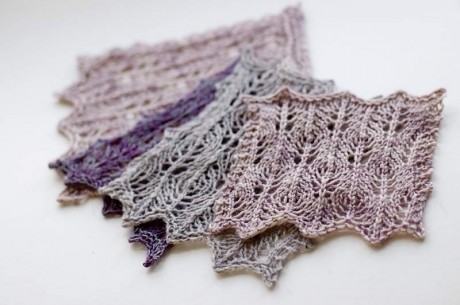
I was recently reminded how confusing the issues around blocking finished knits can be. To wet block or steam? Use blocking wires or not? Iron, steam or leave to dry?
Many people I come across also believe that the stated needles and gauge on a pattern are set in stone. They understand they can substitute a similar weight yarn but don’t feel they have permission to experiment with the needles and gauge. This isn’t true. It may be more complicated to do this when knitting a fitted garment but it is a pleasure to do when knitting shawls, scarves and other items where dimensions are less crucial.
I begin every project with a stack of samples, trying out different yarns and gauges and seeing what they look, feel and drape like when they are blocked.
I’ll demonstrate what I mean using samples knit for the Beginner’s Lace Shawl. I began by knitting samples of the pattern in different yarns and with different needle sizes. This is how a couple of them look fresh off the needles. Not very impressive.
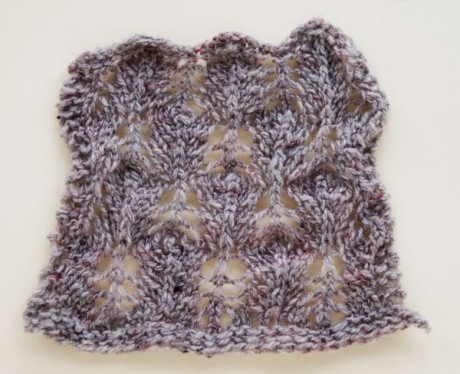
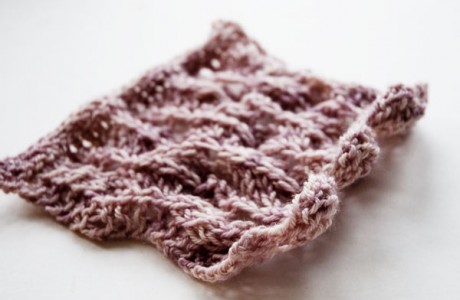
It may surprise you that one of these swatches is a double knitting (DK) weight sample for a lace shawl. But why not? Lace can be in any weight of yarn.
Next, I always wet block my swatches and finished knits, even if I want them to remain textural (such as with cables). My reasoning for this is that they will eventually have to be washed so you might as well know how the fabric will respond before beginning. Many yarns soften and bloom after they have been washed for the first time. It’s also the best way to set your stitches. Wool will remember how it has been blocked, open or textural, but will need reminding every time you wash it.
I wash my knits by filling the sink with warm water. There is no danger of your knits felting in warm water without agitation. I then add a tsp of Eucalan, swish the water with my hands and add the knit. Leave it alone for 15 minutes. When you return, the bubbles will have subsided and it is ready to remove. No rinse is necessary with Eucalan.
I keep some old towels in my bathroom for rolling my knits in. I remove them from the sink, supporting their weight if they are large items, and then roll them up in a towel like a sushi filling, to remove excess water. Remove as much moisture as you can this way.
I then take the knit to my blocking area. I use interlocking foam mats, such as you buy for children’s play-mats, to pin my knits to. I connect as many as I need to lay out my knit flat and then lay towels on top. If I am using blocking wires, I insert them now.
Blocking Wires are both time-saving and help to give better results, particularly with openwork stitches. They are great for keeping edges perfectly straight.
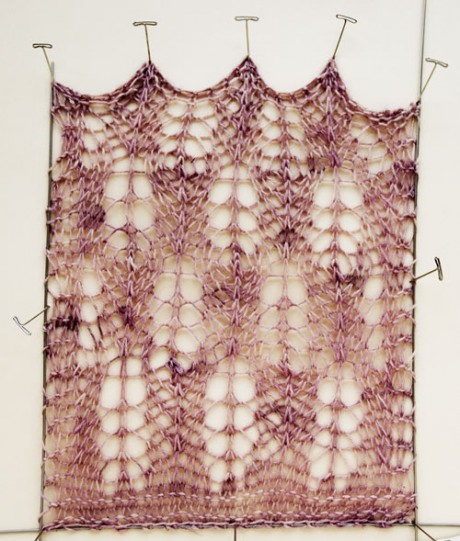
This sample is knit with Uncommon Thread BFL Sport/DK, using large needles (think size 5mm where a 3mm might do). This makes the lace eyelets really big when stretched. The wires are threaded through the sample sides and bottom. A few T-pins are used to stretch the wires apart, opening up the sample. At the top, I could have inserted the wire through the tips of the lace points and pinned it in place but I just pinned each point out. Allow it to dry fully. (You can always use a hairdryer if you’re in a hurry.)
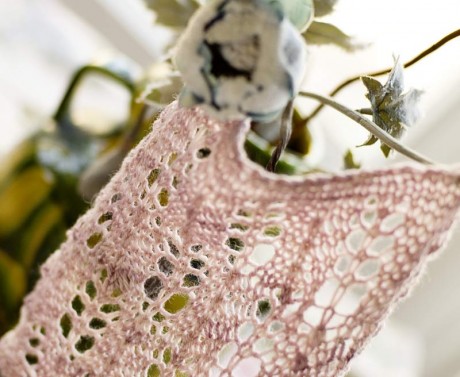
You can see how the very open quality of this sample is maintained by the wet block. Smaller needles could have been used for a less open look, as they are in the sample below. Here the needles are two full sizes smaller. Notice how the lace eyelets (holes) are smaller.
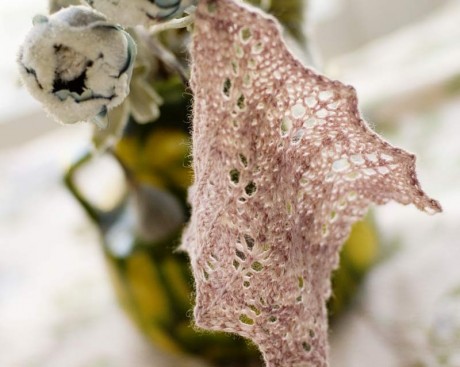
Choosing your gauge/needle size is purely a matter of personal taste. The larger your needles are, the larger your lace shawl will be with a given ball of yarn and the more “open” your lace. Hairier yarns, such as mohair and alpaca, will fill-in or “bloom” and usually look best in looser tensions. More tightly twisted yarns, such as some sock yarns can look stringy if the tension is very loose. The best way to decide is to knit a few samples and compare them. Choose the fabric that you like the look of.
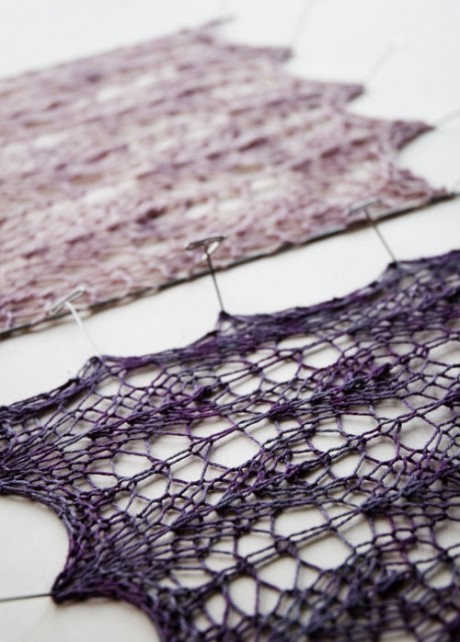
The sample at the front of the picture above has not used any blocking wires. It is pinned out in peaks all around the edges. These peaks and valleys will be set in the wool after blocking and are a simple way to achieve this look without shaping in the knit. This is the beautiful DyeForYarn Fingering Merino/Silk.
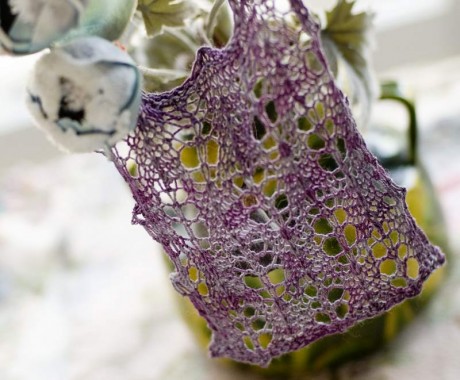
I sometimes use steam from my iron for very quick results or to touch up blocked samples. For instance, if I were to make a sweater in pieces, I would wash and wet block each of the pieces before sewing together. After sewing the seams together I blast them with steam from the iron. I never touch my iron directly to my knits as this flattens the stitches.
Finally a picture to show how radically a knit changes before and during blocking.
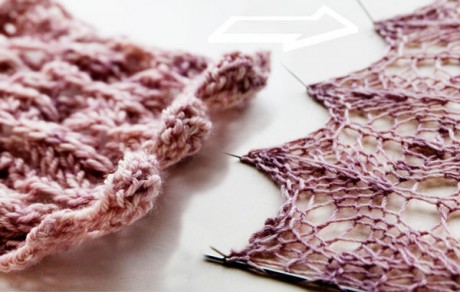
I hope this is some help to you as you prepare swatches for your own projects. Be bold and try new fibres, yarns and colours! And see our collection of tools to help you with blocking here!
~Juju at Loop
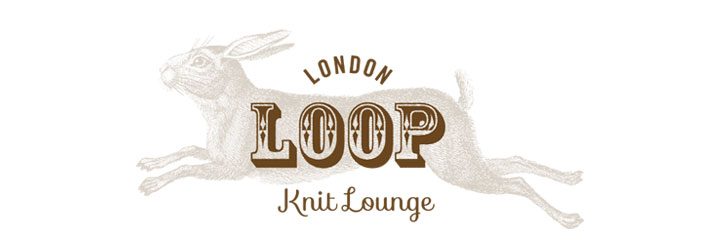
Such a helpful blog. I would love advice on how to handle the finished (and substantially bigger!) article in this way?
Thank you so much for this excellent article! I was just asking about blocking yesterday at my local knit shop. They told me about blocking wires, and pins, etc., and now, here it is, illustrated. Thanks again!
Karen :)
This was very helpful!
Thank you
very helpful..many thanks
Thanks for this informative article. I have always wondered how to block yarns which are “dry clean only” such as the Tilli Tomas Symphony kid lace with bead and glitter. What do you suggest?
I suggest hand-washing.
Thanks for this really informative, clear article. I wondered if I was blocking correctly and your article is very useful and clear. I found the before and after pics very helpful as well as the different yarns used!